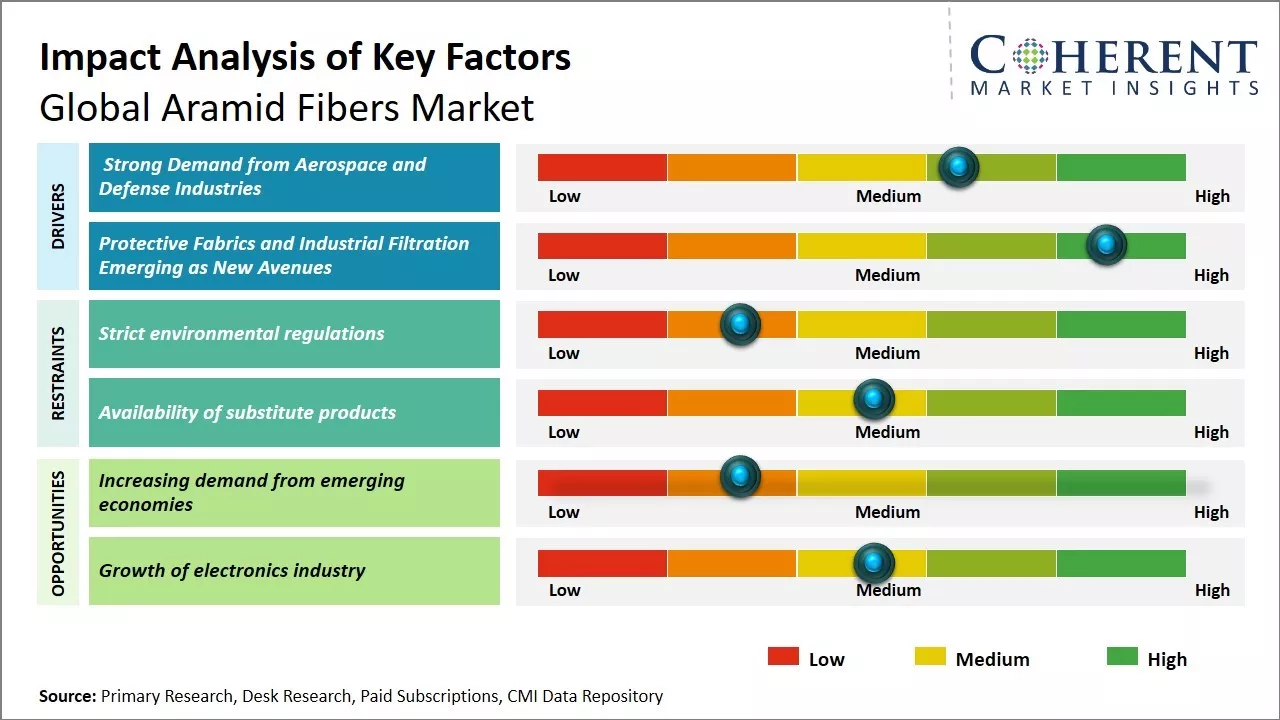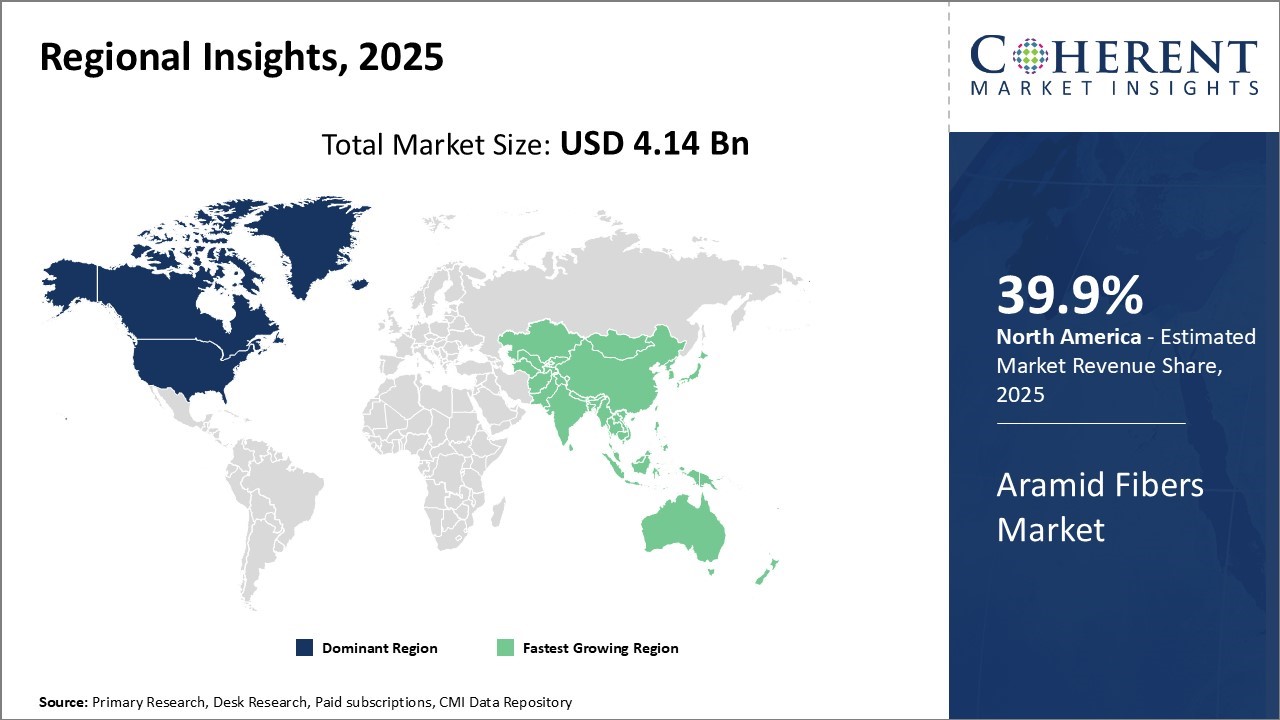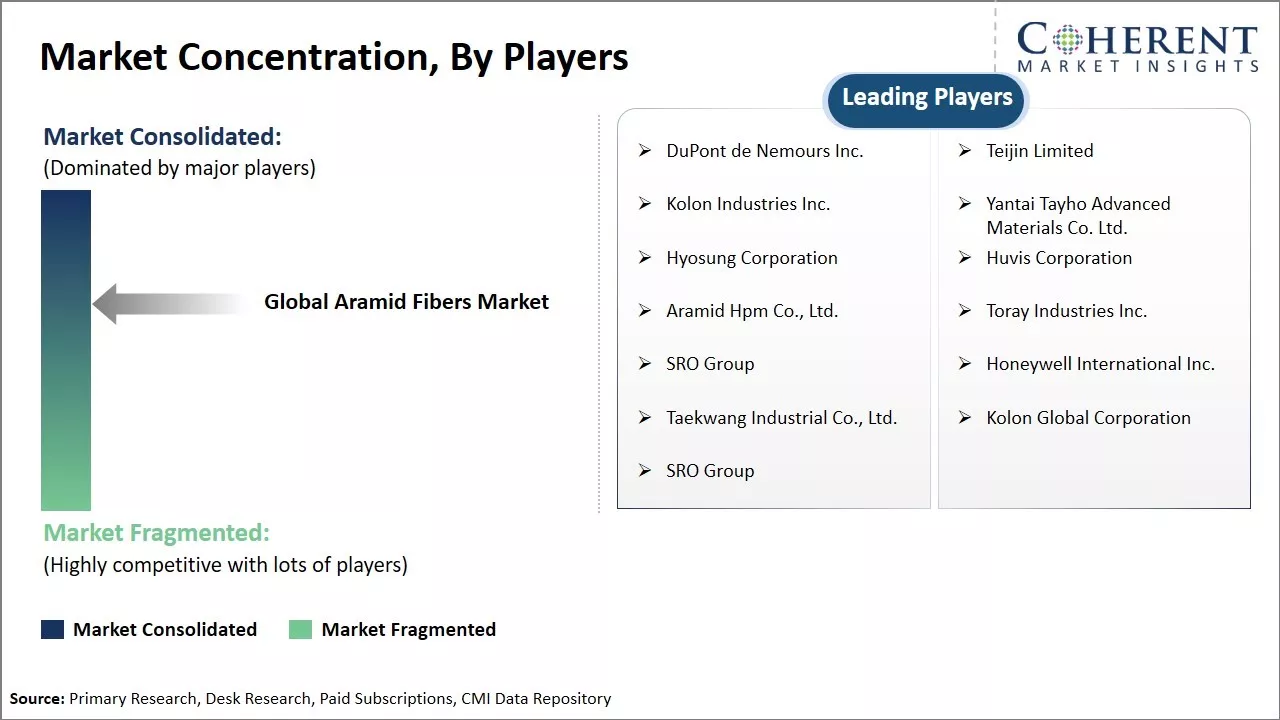The global aramid fibers market is estimated to be valued at USD 4.14 Bn in 2025 and is expected to reach USD 7.73 Bn by 2032, growing at a compound annual growth rate (CAGR) of 9.3% from 2025 to 2032.

To learn more about this report, Download Free Sample
The market is witnessing positive trends due to increase in demand from the automotive and ballistic protection sectors. Aramid fibers are increasingly being used in automotive applications such as tires, airbags, hoses, etc. due to their high strength to weight ratio property. There has also been a rise in the usage of aramid fabrics for ballistic protection equipment such as bulletproof vests, helmets, and armor plates for military and law enforcement agencies. Additionally, growing infrastructure development activities are also driving demand for aramid fibers which are used for the manufacture of construction materials, optical fiber cables, and other industrial applications.
|
Current Events |
Description and its impact |
|
Growing Application of Aramid Fibers in Automotive and Ballistic Industry |
|
|
Integration of Aramid Fibers in Future-Generation Optical Fiber Cables and Infrastructure Projects |
|
Uncover macros and micros vetted on 75+ parameters: Get instant access to report
New technologies are having a revolutionary impact upon the development and innovation of the aramid fibers market. Aramid fibers, originally used in ballistic body armor and fire-resistant garments, are being further developed with advancements in nanotechnology, materials science, and smart manufacturing. Applications involving nanomaterials such as graphene and carbon nanotubes, for example, are facilitating the creation of next-generation aramid composites that are stronger, lighter, and more durable and resistant to environmental exposure. These hybrid composites are creating new applications in aerospace, electronics, and high-performance sports gear.
Meanwhile, new digital manufacturing technologies like 3D weaving and automated fiber placement are enhancing aramid fiber processing precision and efficiency. The technologies minimize waste, accelerate production, and allow for custom tailoring of fiber structure to performance requirements. Sustainable chemistry advances are also contributing to advances in cleaner aramid production processes, such as the use of bio-based solvents and recyclable composites, that are at the heart of the achievement of global sustainability objectives.
In addition, the development of intelligent textile is opening up great potential for aramid fibers to be embedded with sensors and conductive materials—providing protection and feedback information in real time. This is especially useful for defense, firefighting, and industrial applications where situational awareness is key. In general, emerging technologies are not only adding to the attributes of aramid fibers but expanding their applicability to more sectors of advanced, technology-based industries.
The aerospace and defense industries have always pushed the boundaries of innovation and are early adopters of advanced materials that can deliver strength, stiffness and heat resistance. Aramid fibers have found widespread usage in these industries due to their high tensile strength and heat resistance properties. They are used to manufacture various components such as aircraft fuselages, engine mounts, rotor blades, radar domes and more.
With rising global defense budgets and increasing passenger and cargo traffic worldwide, demand from the commercial aviation sector as well as the defense sector continues to grow steadily. Many new aircraft programs are ongoing or have been announced recently which will fuel the increasing usage of composites containing aramid fibers. Military agencies across countries are procuring new fighter jets, transport aircraft, helicopters and missiles. Composite materials allow manufacturers to build lighter yet stronger structures, enabling these aircraft and platforms to travel farther distances or carry heavier payloads.
In 2025, Airbus expanded its use of aramid fiber composites in the production of next-generation aircraft, particularly within the A320neo and A350 XWB programs, to enhance fuel efficiency and reduce structural weight. The aramid materials—mainly Kevlar and Twaron—are used in aircraft cargo linings, cabin interiors, and radomes due to their superior strength-to-weight ratio and thermal resistance.
While aramid fibers have long been valued for their use in technical textiles and composites, new application areas are opening up as material properties are better explored. Their high strength and heat resistance makes aramid an ideal candidate for protective clothing, often combined with other fibers. Industries like oil & gas, manufacturing and fire-fighting require durable and heat-shielding garments and equipment to safeguard workers from hazards.
Stringent safety regulations and awareness about personnel protection are driving demand from this sector. Industrial processes also seek filtration media that can operate at high temperatures and resist abrasion. Aramid fiber filters are gaining preference for collecting fine dust particles as well as removing oil and liquid contaminants. Areas such as coal power generation and metal processing require filters that can withstand demanding conditions for long useful lives.
Aramid fibers effectively meet the performance needs of these applications compared to alternatives. With emerging economies industrializing rapidly, there will be growing need for advanced technical textiles and high-filtration nonwovens duly complemented by aramid.
Demand is increasing from emerging economies due to economic development. Applications in ballistic protection and nanocomposites are driving new product innovation. The automotive and aerospace industries continuously seek lightweight high-strength materials. Additionally, stable relationships with raw material suppliers ensure availability. Additionally, market players can target replacements for asbestos and other hazardous materials.
Para-aramid fibers have gained widespread adoption in the security and protection due to their exceptional ballistic resistance. It is expected to account for 72.2% of the market share in 2025. These fibers are able to effectively stop projectiles like bullets, shards of glass, and other damaging debris. The chemical structure of para-aramid fibers allows for extremely strong intermolecular bonds between polymer chains, resulting in an ultra-high tensile strength that makes it very difficult for high-velocity projectiles to penetrate.
Para-aramid is commonly used in the fabrication of bulletproof vests, ballistic panels, and other personal protective equipment. Its lightweight yet robust ballistic resistance has made it an indispensable component in protecting law enforcement, military personnel, and private security guards. The functionality it provides in preventing lethal injuries from firearms is unmatched by other fiber materials. Recent advancements have improved para-aramid fibers' comfort and breathability as well, addressing prior limitations and expanding its use in protective apparel.
Another major driver of para-aramid demand is its use in friction material applications such as brake linings and clutches. Its high thermal conductivity helps dissipate heat generated during heavy braking or clutch engagement. The outstanding heat resistance of para-aramid prevents brake pads and clutch facings from deteriorating prematurely due to excessive heat. This maintains consistent braking and clutch performance over the lifetime of the part. Its use enhances safety and reduces maintenance and replacement costs in applications ranging from aircraft and vehicles to industrial machinery.
The security and protection sub-segment in the application segment currently dominates the global aramid fiber demand, and it is projected to hold 37.2% of the market share in 2025. This is due to the vital role aramid fibers play in manufacturing body armor, bullet-resistant equipment, and infrastructure protection products. Government spending on military, law enforcement, and first responder safety equipment has contributed significantly to the segment's growth.
In recent years, there has been an increased emphasis on providing reliable ballistic protection across high-risk professions and regions in response to escalating geopolitical threats and violent incidents. Another major factor is the surge in demand for bulletproof materials in the private security industry. Wealthy individuals, VIPs, cash-in-transit companies, and organizations operating in unstable areas are allocating greater budgets to protective gear.
Aramid fibers allow manufacturers to develop lighter, more wearable solutions that meet rigorous ballistic standards without compromising mobility or durability. Infrastructure protection has also seen rising aramid fiber consumption. Applications include reinforced building panels, barriers, and shields deployed at government facilities, border checkpoints, and public event venues. Here, aramid's unique ability to withstand repeated impacts from explosives, projectiles, and other dangerous forces without degrading makes it the material of choice.

To learn more about this report, Download Free Sample
North America has established itself as the dominant region in the global aramid fibers market. The region is expected to account for 39.9% of the market share in 2025. With large automobile, aerospace, and defense industries, the region sees significant demand for aramid fibers which find key applications in these end-use industries.
The presence of leading aramid fiber manufacturers such as DuPont and Teijin further strengthens the supply chain network in the region. The strong production capabilities and advantages of economies of scale allow North American manufacturers to consistently meet the bulk of regional demand in a cost-effective manner while also exporting to other parts of the world.
The Asia Pacific region has emerged as the fastest growing market for aramid fibers in recent years. Countries such as China, India, Japan, and South Korea are actively promoting their manufacturing sectors which has fueled the growth of end-use industries for aramid fibers. The expanding automotive production and rising aircraft demand from China has particularly boosted the Asia Pacific market.
The numerous protection standards in the region regarding human safety have also increased the adoption of aramid fiber-based protective clothing and equipment. Additionally, several international aramid fiber producers are setting up local manufacturing plants in Asia Pacific to capitalize on the market potential as well as hedge risks from wage inflation and trade barriers in their home markets.
The U.S. dominates the aramid fibers industry because of its robust defense, aerospace, and automobile sectors. Companies such as DuPont (which manufactures Kevlar and Nomex) spearhead technology and mass production and are backed by consistent military orders and high demand for protective equipment and lightweight materials.
China is aggressively increasing its aramid fiber manufacturing capacity, supported by the government and growing local demand in construction, electronics, and transportation. Chinese producers are gaining competitiveness in overseas markets through enhanced quality and more affordable substitutes.
Japan is very strong in the aramid market, particularly in high-tech areas such as optical fibers, automobile parts, and advanced composites. Teijin (the company that produces Twaron and Technora) is an example of firms with high-quality fiber production and excellent R&D capabilities.
Germany is a key player in the European aramid market, driven by its advanced automotive and industrial sectors. The country focuses on innovation in composite materials and sustainability, often incorporating aramid fibers into high-performance components and safety products.
South Korea is becoming a competitive force, spending on local manufacturing and technology creation to supplement its robust electronics and industrial base. The nation is increasingly adopting aramid fibers in telecommunications, battery insulation, and lightweight protective equipment.
| Report Coverage | Details | ||
|---|---|---|---|
| Base Year: | 2024 | Market Size in 2025: | USD 4.14 Bn |
| Historical Data for: | 2020 To 2024 | Forecast Period: | 2025 To 2032 |
| Forecast Period 2025 to 2032 CAGR: | 9.3% | 2032 Value Projection: | USD 7.73 Bn |
| Geographies covered: |
|
||
| Segments covered: |
|
||
| Companies covered: |
DuPont de Nemours Inc., Teijin Limited, Kolon Industries Inc., Yantai Tayho Advanced Materials Co. Ltd., Hyosung Corporation, Huvis Corporation, Aramid Hpm Co., Ltd., Toray Industries Inc., SRO Group, Honeywell International Inc., Taekwang Industrial Co., Ltd., Kolon Global Corporation, and SRO Group |
||
| Growth Drivers: |
|
||
| Restraints & Challenges: |
|
||
Uncover macros and micros vetted on 75+ parameters: Get instant access to report

To learn more about this report, Download Free Sample
Share
Share
About Author
Yash Doshi is a Senior Management Consultant. He has 12+ years of experience in conducting research and handling consulting projects across verticals in APAC, EMEA, and the Americas.
He brings strong acumen in helping chemical companies navigate complex challenges and identify growth opportunities. He has deep expertise across the chemicals value chain, including commodity, specialty and fine chemicals, plastics and polymers, and petrochemicals. Yash is a sought-after speaker at industry conferences and contributes to various publications on topics related commodity, specialty and fine chemicals, plastics and polymers, and petrochemicals.
Missing comfort of reading report in your local language? Find your preferred language :
Transform your Strategy with Exclusive Trending Reports :
Frequently Asked Questions
Joining thousands of companies around the world committed to making the Excellent Business Solutions.
View All Our Clients